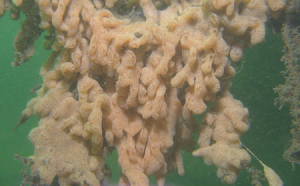 At the end of January (2014), the New Hampshire Business Review featured a front-page article about the economic costs of invasive species in New Hampshire. In August of 2013, a team of researchers, including UNH professor Larry Harris, did a one-day sweep of several sites in along the New Hampshire coast searching for non-native plants and animals. Their effort included stops at Hampton River Marina and the Coastal Marine Laboratory, a UNH facility in New Castle. Researchers have been conducting these sweeps every 3 years since 2000. And while this year, no new introduced species were discovered, the team saw that the composition of communities was changing with higher relative abundances of some established invasive species. For example the invasive sea squirt called ciona, has become a dominant species at places like the Hampton River Marina. These creatures wreak havoc on aquaculture; clogging nets, fouling the netting of cages, and overgrowing mussels. Another dominant invasive species to inhabit the coastal waters of New Hampshire and New England is didemnum (another type of sea squirt). Didemnum is a serious marine pest, growing in thick, sheet-like colonies that attach to anything they can get a hold of, moorings, docks, boat ramps, etc.. They also clog intakes to cooling systems of water treatment plants.
At the end of January (2014), the New Hampshire Business Review featured a front-page article about the economic costs of invasive species in New Hampshire. In August of 2013, a team of researchers, including UNH professor Larry Harris, did a one-day sweep of several sites in along the New Hampshire coast searching for non-native plants and animals. Their effort included stops at Hampton River Marina and the Coastal Marine Laboratory, a UNH facility in New Castle. Researchers have been conducting these sweeps every 3 years since 2000. And while this year, no new introduced species were discovered, the team saw that the composition of communities was changing with higher relative abundances of some established invasive species. For example the invasive sea squirt called ciona, has become a dominant species at places like the Hampton River Marina. These creatures wreak havoc on aquaculture; clogging nets, fouling the netting of cages, and overgrowing mussels. Another dominant invasive species to inhabit the coastal waters of New Hampshire and New England is didemnum (another type of sea squirt). Didemnum is a serious marine pest, growing in thick, sheet-like colonies that attach to anything they can get a hold of, moorings, docks, boat ramps, etc.. They also clog intakes to cooling systems of water treatment plants.
Today, there are some efforts to slow the colonization of invasive species, including, stricter rules about cleaning ballast water in commercial ships and having boat ramp monitors inspect boats and trailers upon pull out. But there is still not enough action and there seems to be very little interest from funding agencies to support research to understand how invasive species impact the ecosystem, as well how to deal with them.
For more information and to read the entire article click here.